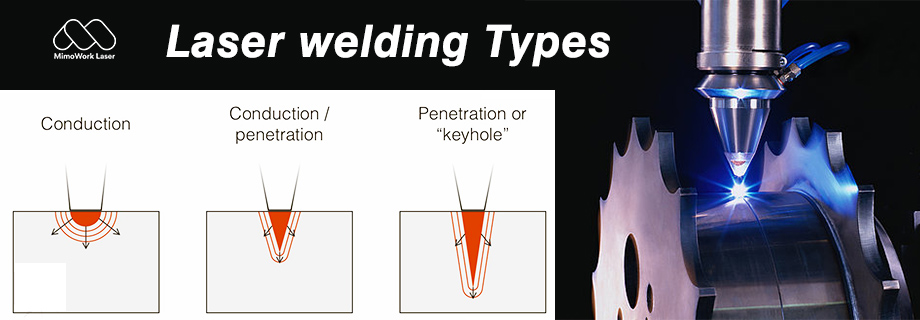Laser welding can be realized by the continuous or pulsed laser generator. The principle of laser welding can be divided into heat conduction welding and laser deep fusion welding. Power density less than 104~105 W/cm2 is heat conduction welding, at this time, the depth of melting, and welding speed is slow; When the power density is greater than 105~107 W/cm2, the metal surface is concave into "keyholes" under the action of heat, forming deep fusion welding, which has the characteristics of fast welding speed and large depth-width ratio.
Today, we will mainly cover the knowledge of major factors that affect the quality of laser deep fusion welding
1. Laser Power
In laser deep fusion welding, laser power controls both penetration depth and welding speed. The weld depth is directly related to the beam power density and is a function of the incident beam power and the beam focal spot. Generally speaking, for a certain diameter laser beam, the penetration depth increases with the increase of beam power.
2. Focal Spot
Beam spot size is one of the most important variables in laser welding because it determines the power density. But measuring it is a challenge for high-power lasers, although there are many indirect measurement techniques available.
The diffraction limit spot size of the beam focus can be calculated according to the diffraction theory, but the actual spot size is larger than the calculated value due to the existence of poor focal reflection. The simplest measurement method is the iso-temperature profile method, which measures the diameter of the focal spot and perforation after the thick paper is burnt and penetrated through the polypropylene plate. This method through the measurement practice, masters the laser power size and beam action time.
3. Protective Gas
The laser welding process often uses protective gases (helium, argon, nitrogen) to protect the molten pool, preventing the workpiece from oxidation in the welding process. The second reason for using protective gas is to protect the focusing lens from contamination by metal vapors and sputtering by liquid droplets. Especially in high-power laser welding, the ejecta becomes very powerful, it is necessary to protect the lens. The third effect of the protective gas is that it is very effective in dispersing the plasma shielding produced by high-power laser welding. The metal vapor absorbs the laser beam and ionizes into a plasma cloud. The protective gas around the metal vapor also ionizes due to heat. If there is too much plasma, the laser beam is somehow consumed by the plasma. As the second energy, plasma exists on the working surface, which makes the weld depth shallower and the weld pool surface wider.
How to choose proper shielding gas ?
4. Absorption Rate
The laser absorption of the material depends on some important properties of the material, such as absorption rate, reflectivity, thermal conductivity, melting temperature, and evaporation temperature. Among all of the factors, the most important is the absorption rate.
Two factors affect the absorption rate of the material to the laser beam. The first is the resistance coefficient of the material. It is found that the absorption rate of the material is proportional to the square root of the resistance coefficient, and the resistance coefficient varies with temperature. Secondly, the surface state (or finish) of the material has an important influence on the absorption rate of the beam, which has a significant effect on the welding effect.
5. Welding Speed
The welding speed has a great influence on the depth of penetration. Increasing the speed will make the depth of penetration shallower, but too low will lead to excessive melting of materials and workpiece welding through. Therefore, there is an appropriate welding speed range for a particular material with certain laser power and a certain thickness, and the maximum penetration depth can be obtained at the corresponding speed value.
6. Focal Length of the Focus Lens
A focus lens is usually installed in the head of the welding gun, generally, a 63~254mm (diameter 2.5 "~10") focal length is selected. Focusing spot size is proportional to the focal length, the shorter the focal length, the smaller the spot. However, the length of focal length also affects the depth of focus, that is, the depth of focus increases synchronously with the focal length, so the short focal length can improve the power density, but because the depth of focus is small, the distance between the lens and the workpiece must be accurately maintained, and the depth of penetration is not large. Due to the influence of splashes and laser mode during welding, the shortest focal depth used in actual welding is mostly 126mm (diameter 5 "). A lens with a focal length of 254mm (diameter 10 ") can be selected when the seam is large or the weld needs to be increased by increasing the spot size. In this case, a higher laser output power (power density) is required to achieve the deep penetration hole effect.
More questions about handheld laser welding machine price and configuration
Post time: Sep-27-2022


